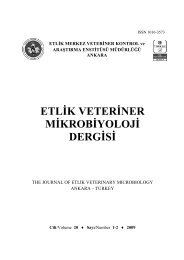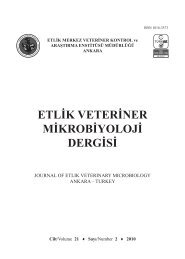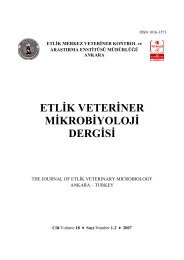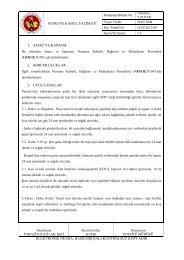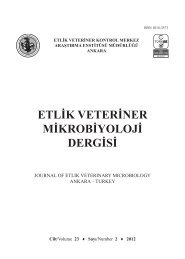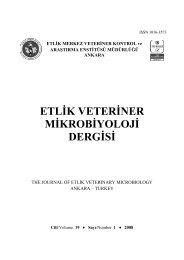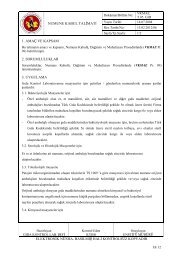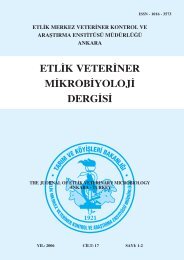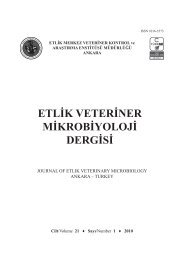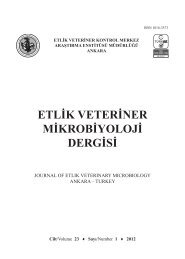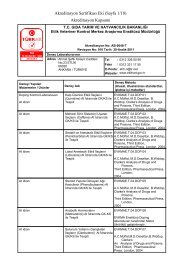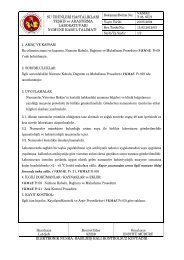etlik veteriner mikrobiyoloji dergisi - veteriner kontrol merkez ...
etlik veteriner mikrobiyoloji dergisi - veteriner kontrol merkez ...
etlik veteriner mikrobiyoloji dergisi - veteriner kontrol merkez ...
You also want an ePaper? Increase the reach of your titles
YUMPU automatically turns print PDFs into web optimized ePapers that Google loves.
52<br />
Albayrak ve ark. Etlik Vet Mikrobiyol Derg, 22, 49-53, 2011<br />
with no sites of insertion or deletion. The neighbor<br />
joining tree was generated and given in figure 2. Our<br />
analyses, based on the mitochondrial genes cytochrome<br />
b (a common species-level marker), suggest<br />
that this kind of markers are capable of discriminating<br />
bat species with high accuracy. Morphologically<br />
identified species have also identified genetically in<br />
this study.<br />
Discussion and Conclusion<br />
Up to now, 38 bat species were recorded from Turkey<br />
(10). Predominantly, researchers from Turkey<br />
prefer morphological studies about bats and they<br />
published their findings. Morphological characterization<br />
of bat species should be applied as an essential<br />
protocol (5). But, identification of bat species<br />
using molecular tools will also be possible in conjunction<br />
with bat characterization of morphological<br />
features. Especially, samples are damaged or identification<br />
from morphological criteria is not possible<br />
or if the specimen is degraded or visual inspection<br />
is not possible or the morphological expertise is not<br />
available or large-scale studies are needed.<br />
The rapid and accurate identification of species<br />
is a critical component of large-scale biodiversity<br />
monitoring programs (17). Substantial sequence<br />
divergence suggests an unexpected high number of<br />
undiscovered species (24).<br />
The phylogenetic studies were done for two bat<br />
species by different research groups in recent years<br />
in Turkey. Only, M.schreibersii, M.capaccinii and<br />
Plecotus kolombatovici have been studied (12, 13,<br />
20). Therefore we need more molecular works and<br />
comparative studies on all bat species.<br />
Three different species were chosen and analyzed<br />
cytochrome b gene of this species to show<br />
for future expectation. Study showed that DNA<br />
markers are valuable molecular methods for biodiversity<br />
monitoring programs in Turkey. Therefore,<br />
sequencing-based comparisons could provide more<br />
flexibility in large-scale studies for Turkish bat species.<br />
Also, results gave us an idea about sequence<br />
divergence estimation in bat population in Turkey,<br />
because there is no completed similar study.<br />
The cytochrome b gene sequences for the three<br />
Turkish bat species in this study were compared<br />
with sequences available from GenBank. All of the<br />
sequences are highly similar to those of published<br />
specimens. The sequence similarity is ranging between<br />
86% and 99%.<br />
We present a framework for future characterization<br />
of the impact of sequence detection, morphological<br />
characterization and building a DNA library<br />
for Turkish bat species.<br />
Author’s Contributions<br />
HU carried out the fieldwork and molecular genetic<br />
studies, performed analyses and drafted the manuscript.<br />
IA coordinated the fieldwork and helped in<br />
drafting the manuscript. NA and NU helped drafting<br />
the manuscript. OA carried out the fieldwork,<br />
supervised the laboratory works and helped in drafting<br />
the manuscript. TM and CF helped in drafting<br />
manuscript. All authors read and approved the final<br />
manuscript.<br />
Acknowledgements<br />
We would like to thank Prof. Dr. A.R. Fooks for<br />
suggestion, Dr. Nahit Yazıcıoğlu for logistic supports<br />
and comments and Dr. Tarkan Yorulmaz for<br />
obtaining samples.<br />
References<br />
1. Albayrak İ, (1990). Doğu Anadolu yarasaları (Mammalia:<br />
Chiroptera) ve yayılışları. Doğa Tr. J. Zool. 14, 214-228.<br />
2. Albayrak İ, (1993). Batı Anadolu yarasaları ve yayılışları<br />
(Mammalia: Chiroptera). Doğa Tr. J. Zool. 17, 237-257.<br />
3. Albayrak İ, (2003). The bats of the Eastern Black Sea Region<br />
in Turkey (Mammalia: Chiroptera). Turk J. Zool. 27,<br />
269-273.<br />
4. Albayrak İ, Aşan N, (1998). Geographic variations and<br />
taxonomic status of Myotis myotis (Borkhausen, 1797) in<br />
Turkey (Chiroptera: Vespertilionidae). Turk. J. of Zoology.<br />
22, 267-275.<br />
5. Albayrak İ, Aşan N, (1999). Distributional status of the bats<br />
from Turkey (Mammalia: Chiroptera). Commun. Ac. Sci.<br />
Univ. Ank. Series C. 17, 59-68.<br />
6. Albayrak İ, Aşan N, (2001). The Structure of baculum in<br />
Myotis myotis and Myotis blythii (Chiroptera: Vespertilionidae).<br />
Turk. J. of Zool. 25 (3), 229-233.<br />
7. Albayrak İ, Aşan N, Yorulmaz T, (2008). The natural history<br />
of the Egyptian fruit bat Rousettus aegyptiacus in Turkey<br />
(Mammalia: Chiroptera). Turk. J. of Zool. 32, 11-18.<br />
8. Amr ZS, Abu Baker MA, Qumsiyeh MB, (2006). Bat diversity<br />
and conservation in Jordan. Turk J. Zool. 30, 235-<br />
244.<br />
9. Aşan N, Albayrak İ, (2006). A study on the breeding biology<br />
of some bat species in Turkey. Turk. J. of Zool. 30,<br />
103-110.



